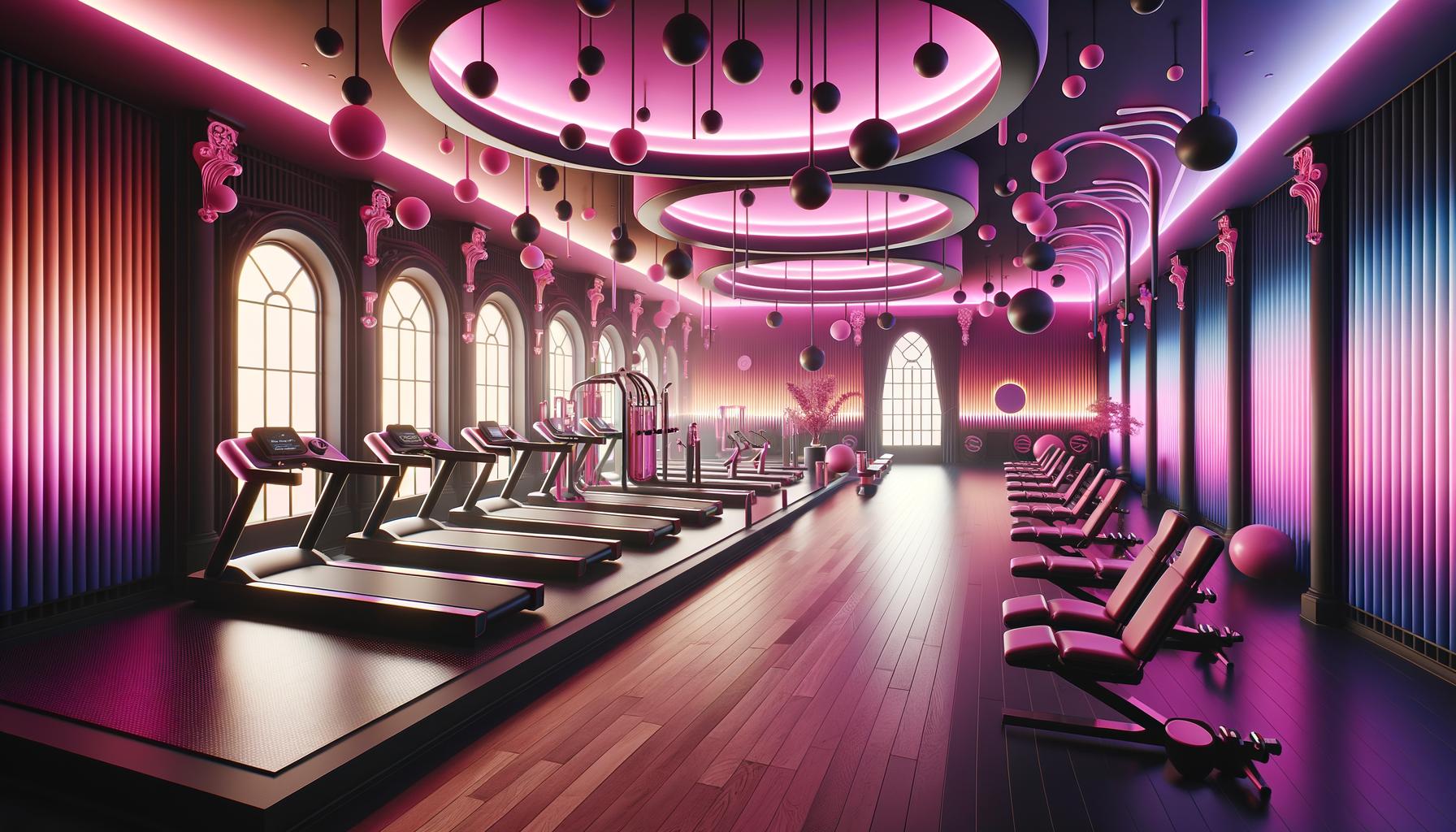· fitness · 11 min read
Enhancing Workouts: How Adjustable Sensory Settings Benefit Neurodiverse Individuals
Discover how adjustable sensory settings in fitness spaces enhance workouts for those with sensory sensitivities.

In This Post
The Fact Why Should I Care How To Put In Action Start Tomorrow Guide How does it effect my ability to focus How does it impact my daily life How does it help me make friends How does it help me manage stress How does it effect my mood Summary: Remember Refresher Checklist FAQs on adjustable sensory settings in fitness spaces The Full Research Article CitationsThe Zero-Trust Way
Fact Check Results
The following stats are based on the fact-checking process of this article.
Why should I care about adjustable sensory settings in my fitness spaces?
Discover the reasons why adjustable sensory settings in fitness spaces is important for autistic or neurodiverse individuals.
Adjustable sensory settings in fitness areas create a more manageable zone where you feel in control, helping you stay focused and comfortable during workouts.
Fitness spaces that suit your sensory needs enable you to exercise, so that, you can learn to build routine and feel more independent and self-sufficient.
Fitness spaces with adjustable settings can foster a supportive community, offering social opportunities to connect with others who share your experiences and preferences, potentially leading to new friendships.
Sensory-adjustable environments let you control stimuli intensity, reducing discomfort and stress during workouts, making exercise more sustainable and enjoyable.
When exercise is more pleasant and less stressful, you not only enjoy the activity more but also reap benefits like better health, more energy, and a sense of achievement.
Regular exercise in a comfortable environment boosts mood by releasing endorphins and reducing stress and anxiety, helping maintain mood balance.
Apply this knowledge in your daily life
How can an I begin adding adjustable sensory settings in my fitness spaces?
Here are 6 ways an autistic or neurodiverse individual can apply adjustable sensory settings in fitness spaces in their daily life.
Identify Your Sensory Preferences
Assess and note what specific sensory stimuli (light, sound, temperature) impact you positively or negatively during workouts.
Research Fitness Centers
Look for gyms or fitness centers that offer adjustable sensory settings, or inquire at your local facilities if they can accommodate your sensory needs.
Use Personal Adaptive Devices
If specific settings are not available, consider using personal devices such as noise-canceling headphones, tinted glasses, or personal fans during your workouts.
Plan Your Routine
Create a consistent workout schedule that aligns with times when the gym is less crowded or when the environment can be most easily adjusted to suit your needs.
Slowly Adjust Settings
Start with minimal changes to the environment and gradually adjust the sensory settings to find your optimal setup, which can help in reducing overwhelming feelings.
Engage With The Community
Participate in community forums or groups for neurodiverse individuals who share an interest in fitness to exchange tips and experiences how they navigate sensory needs.
What should I do starting tomorrow to benefit from adjustable sensory settings in fitness spaces?
Step 1: Identify Triggers
Spend 15 minutes noting down which sensory inputs (like bright lights, loud sounds) usually bother you during physical activities.
Step 2: Research Gyms
Take 30 minutes to look online for local gyms that mention adjustable lighting or sound, or call them to ask if they can meet your sensory needs.
Step 3: Prepare Sensory Tools
Gather or order any personal adaptive tools you might need, such as noise-canceling headphones or tinted glasses, taking about 30 minutes.
Step 4: Plan Workout Times
Dedicate 20 minutes to figuring out when gyms are less crowded, planning your visits during these quieter times.
Step 5: Start Small With Settings
During your first gym visit, spend the first 10 minutes adjusting one sensory element (like wearing headphones) and see how it feels.
Step 6: Join Online Forums
Spend 30 minutes finding & joining online communities or forums for neurodiverse individuals interested in fitness.
Step 7: Visit And Adjust
Head to the gym for your first planned session using your tools and knowledge, limiting the initial visit to 45 minutes to assess comfort with your preparations.

Print Out The Tomorrow Checklist!
Sign up for our newsletter and receive a copy today, so that, you can start tomorrow! Or the next day, or the day after that. I forget everything and starting things is hard at least for me so these checklists are godsend.
Effects On Your Ability To Focus
How is my ability to focus improved with adjusting my sensory settings in fitness spaces
By Tailoring Your Sensory Space With Simple Changes It Will Help You Better Concentrate And Feel Comfortable During Workouts. Start With:
Adjusting Your Lighting And Visual Stimuli
Tailoring visual elements like lighting and color can minimize sensory overload, enabling better concentration and reducing distractions.
Customizing Your Auditory Settings
Allowing control over ambient sounds or background music can help individuals filter out auditory distractions and stay focused on their exercise routine.
Tailor For Tactile Experiences
Providing options for different tactile stimuli, such as the texture of equipment or flooring, can enhance comfort and mental focus during workouts.
Control The Temperature And Air Quality
Adjusting the thermal comfort and air quality to suit individual preferences can improve physical comfort and focus, allowing longer and more effective workout sessions.
Effects On Your Independence In Daily Life
How can my independence in my daily life be supported with adjusting my sensory settings in fitness spaces
Enhancing Your Daily Life With Sensory Adjustments Makes You An Active Participant In Your Journey For More Independence.
Enhances Your Autonomy
Adjustable sensory settings in fitness spaces cater to individual sensory needs, increasing the ability of individuals to manage their environment and participate in fitness independently.
Improves Your Life-space Mobility
These settings can enhance movement freedom, enabling individuals to navigate their surroundings more effectively and safely, promoting independence.
Increases Your Confidence
By integrating sensory and monitoring systems, individuals feel supported and confident, fostering independence in managing daily activities.
Reinforces Your Skill Development
Addressing sensory processing challenges enables skill growth crucial for independent living, enhancing participation in various daily tasks.
Effects On My Community Belonging
How can my sense of belonging in the community be fostered with adjusting my sensory settings in fitness spaces
Adjust Your Sensory to Expand Your Social Circle Will Help Build Connections By Making Yourself Comfortable
Enhance Your Comfort
Adjusting sensory settings in fitness spaces allow neurodiverse individuals to feel more at ease, not just you. By fostering a conducive environment for social interactions you will feel more comfortable when the time comes.
Increases Accessibility
By tailoring environments to your sensory needs, autistic or neurodiverse individuals are more likely to frequent these spaces, increasing opportunities for social engagement and building friendships.
Sense Of Belonging
Personalizing sensory settings help neurodiverse individuals feel a sense of place-belongingness in fitness spaces, encourages deeper connections with others and fosters community bonds. You can feel more connected by sharing experiences with others who understand or are just curious about your needs.
Empowerment And Engagement
The ability to control sensory aspects of the environment empowers neurodiverse individuals, making them more active and engaged participants in community activities, thus enhancing social interactions and friendship formation.
Effects On Your Personal Stress
How can my personal stress be better controlled with adjustable sensory settings in fitness spaces
Enhance Your Well-being Through Sensory Control: Preventing Sensory Overload Starts With:
Customizing Your Environments
Adjustable sensory settings in fitness spaces allow personalization that creates a calming environment which prevents sensory overload by reducing unnecessary stress and noise.
Tailoring Your Sensory Experiences
Providing customized sensory settings tailored to individual needs helps reduce overstimulation, fostering a sense of comfort and relaxation during workouts.
Enhancing Your Body Awareness
Sensory adjustments specifically aimed at improving proprioception and body awareness ensure that individuals can manage their stress better and maintain focus, minimizing the risk of sensory overload.
Creating Reliable Sensory Cues
Consistent and adjustable sensory inputs in fitness environments help maintain balance and postural control, preventing stress accumulation and sensory overload.
Effects On Your Enjoyment Of Life
How can my enjoyment of physical activities grow with adjustable sensory settings in fitness spaces
Maximize Enjoyment By Enhancing Your Participation: Joy And Engagement In Physical Activities Enhances Your Overall Life Experiences.
Enhancing Your Engagement
By adjusting your sensory settings this will your boost your enjoyment of the activity, encouraging higher participation.
Increasing Your Self-efficacy And Support
Sensory customization in fitness environments boosts your confidence and perceived social support, increasing your activity enjoyment.
Motivating Yourself Through Music
Incorporating music into adjustable settings boosts your in-task affect and motivation, leading to an enjoyable and engaging workout experience.
Sustained Participation
By creating a pleasant workout environment through sensory adjustments, your are more likely to enjoy and continuously engage in physical activities.
Effects on Your Mood Stability
How can my mood stability be maintained with adjustable sensory settings in fitness spaces
Incorporating Adjustable Sensory Settings Helps To Stabilize Your Mood And Enhance Your Well-being.
Environmental Control
Adjustable sensory settings reduce stress levels by modifying environmental factors like lighting and sound, promoting a calm and stable mood.
Natural Elements
Incorporating natural elements into fitness spaces offers a restorative effect, enhancing tranquility and emotional stability so make sure to do more outdoor activities.
Color Influence
Utilizing variable colored lighting can shift mood states, fostering feelings of calmness and pleasure that contribute to mood stability. If you can't change the lights. Wear colored lenses.
Multi-sensory Engagement
Settings that engage the senses through visual, auditory, olfactory, and tactile stimuli create a supportive environment for emotional well-being and positive mood states.
What should I do to remember all this information about adjusting my sensory settings in fitness spaces?
Step 1: Adjust Lighting And Sound
Choose settings that reduce stress and enhance mood, such as soft blue or green lights and calming sounds.
Step 2: Include Natural Elements
Add elements like plants or water features to your fitness space to help decrease stress and increase calm.
Step 3: Utilize Adaptive Devices
Consider noise-canceling headphones or tinted glasses to manage overwhelming sensory inputs.
Step 4: Create A Consistent Routine
Schedule workouts during less crowded hours for a more controlled environment.
Step 5: Engage With Supportive Communities
Join forums or groups for neurodiverse individuals focused on fitness to share experiences and get support.
Step 6: Slowly Adjust Settings
Start with minimal environmental changes and gradually find your optimal sensory setup.
Step 7: Focus On Personal Preferences
Customize your workout space to match your sensory needs and preferences for a better overall experience.

Print Out The Remember Refresher Checklist!
Sign up for our newsletter and download your own copy of the Remember Refresher Checklist, so that, you can easily put it on your fridge and help you stay on target towards your WHY. Every little bit helps.
FAQs on adjustable sensory settings in fitness spaces
What are adjustable sensory settings in fitness spaces and how do they enhance the workout experience for individuals with sensory sensitivities?
Adjustable sensory settings in fitness spaces refer to modifications that can be made to the lighting, sound, and overall environmental conditions within a fitness setting to accommodate individuals with sensory sensitivities. These settings allow for the adjustment of stimuli like brightness and volume levels, which can be overwhelming for some individuals. Enhancing the workout experience includes reducing the risk of sensory overload, which can lead to anxiety or discomfort, thereby creating a more inclusive and comfortable environment that encourages regular physical activity.
How can fitness centers implement adjustable lighting and sound settings to accommodate users with different sensory needs?
Fitness centers can implement adjustable lighting and sound settings by installing technology that allows control over environmental factors. For lighting, dimmer switches and the option to use softer, non-fluorescent lighting can help. For sound, having areas where volume levels are lower or providing noise-canceling headphones can make a significant difference. Additionally, creating quiet zones or times during which background music is turned off can be beneficial. These adjustments help individuals with sensory sensitivities integrate more comfortably into the fitness environment without feeling overwhelmed.
How do adjustable sensory settings in fitness spaces benefit individuals with autism or sensory processing disorders?
Adjustable sensory settings directly benefit individuals with autism or sensory processing disorders by providing a controlled environment that can cater to their specific sensory needs. This avoids sensory overload, which is common for many individuals on the autism spectrum or with sensory processing disorders, as they often have heightened sensitivities to stimuli such as noise and light. By reducing these sensory challenges, individuals can focus better on their workouts, enjoy increased participation in physical activities, and receive the associated health benefits without undue stress.
What training should staff undergo to effectively manage and utilize adjustable sensory settings in fitness environments?
Staff training should include comprehensive education on sensory sensitivities related to autism and other neurodiverse conditions, as well as hands-on training in operating the adjustable sensory equipment. Employees should understand the reasons behind sensory adjustments and how these help users. Training should also cover recognizing signs of sensory overload and appropriate responses to assist members. Additionally, it's beneficial for staff to learn communication strategies that are effective and respectful when interacting with individuals who have sensory sensitivities. This ensures that all staff can create a supportive and understanding environment, maximizing the benefits of adjustable sensory settings.











